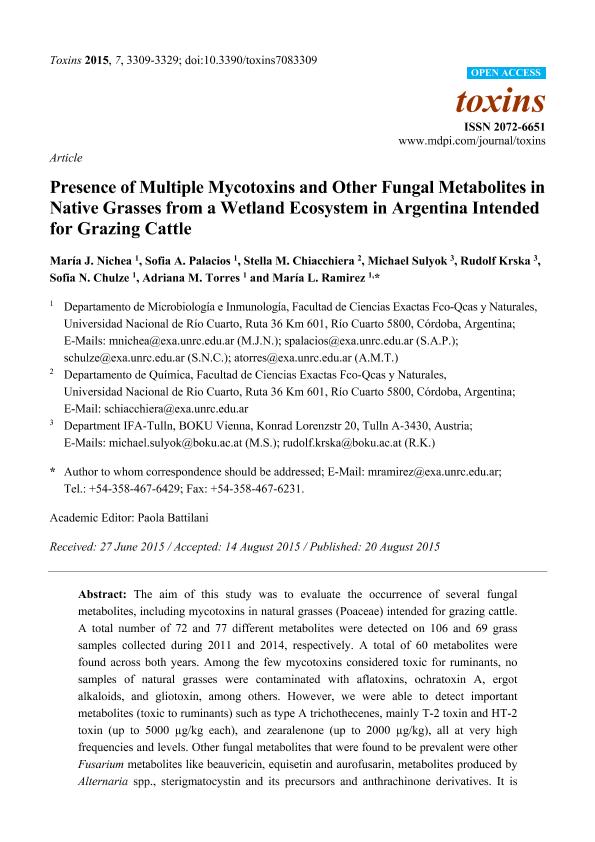Artículo
Presence of multiple mycotoxins and other fungal metabolites in native grasses from a wetland ecosystem in Argentina intended for grazing cattle
Nichea, Maria Julia ; Palacios, Sofia Alejendra
; Palacios, Sofia Alejendra ; Chiacchiera, Stella Maris
; Chiacchiera, Stella Maris ; Sulyok, Michael; Krska, Rudolf; Chulze, Sofia Noemi
; Sulyok, Michael; Krska, Rudolf; Chulze, Sofia Noemi ; Torres, Adriana Mabel
; Torres, Adriana Mabel ; Ramirez, Maria Laura
; Ramirez, Maria Laura
 ; Palacios, Sofia Alejendra
; Palacios, Sofia Alejendra ; Chiacchiera, Stella Maris
; Chiacchiera, Stella Maris ; Sulyok, Michael; Krska, Rudolf; Chulze, Sofia Noemi
; Sulyok, Michael; Krska, Rudolf; Chulze, Sofia Noemi ; Torres, Adriana Mabel
; Torres, Adriana Mabel ; Ramirez, Maria Laura
; Ramirez, Maria Laura
Fecha de publicación:
08/2015
Editorial:
MDPI
Revista:
Toxins
ISSN:
2072-6651
Idioma:
Inglés
Tipo de recurso:
Artículo publicado
Clasificación temática:
Resumen
The aim of this study was to evaluate the occurrence of several fungal metabolites, including mycotoxins in natural grasses (Poaceae) intended for grazing cattle. A total number of 72 and 77 different metabolites were detected on 106 and 69 grass samples collected during 2011 and 2014, respectively. A total of 60 metabolites were found across both years. Among the few mycotoxins considered toxic for ruminants, no samples of natural grasses were contaminated with aflatoxins, ochratoxin A, ergot alkaloids, and gliotoxin, among others. However, we were able to detect important metabolites (toxic to ruminants) such as type A trichothecenes, mainly T-2 toxin and HT-2 toxin (up to 5000 µg/kg each), and zearalenone (up to 2000 µg/kg), all at very high frequencies and levels. Other fungal metabolites that were found to be prevalent were other Fusarium metabolites like beauvericin, equisetin and aurofusarin, metabolites produced by Alternaria spp., sterigmatocystin and its precursors and anthrachinone derivatives. It is important to point out that the profile of common metabolites was shared during both years of sampling, and also that the occurrence of important metabolites is not a sporadic event. Considering that this area of temperate grassland is used for grazing cattle all year long due to the richness in palatable grasses (Poaceae), the present work represents a starting point for further studies on the occurrence of multi-mycotoxins in natural grasses in order to have a complete picture of the extent of cattle exposure. Also, the present study shows that the presence of zeranol in urine of beef cattle may not be a consequence of illegal use of this banned substance, but the product of the natural occurrence of zearalenone and α-zearalenol in natural grasses intended for cattle feeding.
Archivos asociados
Licencia
Identificadores
Colecciones
Articulos(CCT - CORDOBA)
Articulos de CTRO.CIENTIFICO TECNOL.CONICET - CORDOBA
Articulos de CTRO.CIENTIFICO TECNOL.CONICET - CORDOBA
Citación
Nichea, Maria Julia; Palacios, Sofia Alejendra; Chiacchiera, Stella Maris; Sulyok, Michael; Krska, Rudolf; et al.; Presence of multiple mycotoxins and other fungal metabolites in native grasses from a wetland ecosystem in Argentina intended for grazing cattle; MDPI; Toxins; 7; 8; 8-2015; 3309-3329
Compartir
Altmétricas



